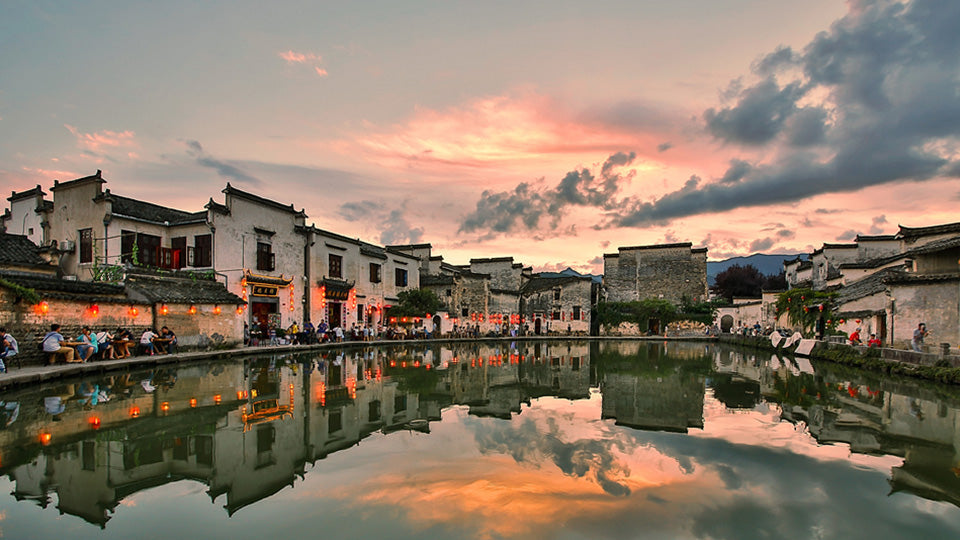
Best Ancient Towns Near Huangshan: Xidi, Hongcun, Chengkan & Bishan Travel Guide
What are the best ancient towns to visit near Huangshan? Is it just the famous UNESCO sites of Xidi and Hongcun, or are there hidden gems worth discovering too? If you’re planning a trip to Anhui Province in East China, this guide highlights the most beautiful ancient villages—Xidi, Hongcun, Chengkan, Bishan, and Xixinan—where Huizhou architecture, living traditions, and stunning landscapes come together.
Why Huangshan and Anhui Are Worth Visiting
Located in East China, Anhui Province has been shaped for centuries by the Yangtze and Huai river systems, producing distinct northern and southern cultures. It’s a land of:
-
Huangshan Mountain (UNESCO World Cultural & Natural Heritage, Global Geopark) — iconic granite peaks, sea of clouds, hot springs.
-
Huizhou architecture, with ancestral halls, memorial archways, and white-walled, black-tiled houses.
-
Cultural treasures, such as the Four Treasures of the Study (ink brush, ink, paper, and inkstone).
-
Anhui cuisine, one of China’s Eight Great Culinary Traditions, known for bold, earthy flavors.
Together, Huangshan and its surrounding villages offer travelers a blend of nature, culture, and cuisine that embodies the essence of slow travel.

Xidi and Hongcun: UNESCO World Heritage Villages
-
Xidi: Founded in the 11th century, Xidi is shaped like a boat and follows feng shui principles. Its stone archway, clan halls, and Hu family residences are classic examples of Huizhou design.
-
Hongcun: Established in the Southern Song Dynasty, Hongcun is known as the “Ox-Shaped Village.” The Moon Pond (the ox’s stomach) and canals still provide water for daily life and fire prevention. Featured in Crouching Tiger, Hidden Dragon, it’s a favorite for photographers and history lovers.
Chengkan: The Feng Shui Village
With a history of over 1,800 years, Chengkan is laid out according to the Bagua (Eight Trigrams) of Daoist cosmology. It is filled with Ming Dynasty residences, ancestral temples, and peaceful waterways. Chengkan is also home to the Fish Lantern Festival, a vibrant folk tradition celebrated for centuries.

Bishan: A Creative Renaissance
Bishan Village offers a refreshing contrast to the busier UNESCO sites. Revitalized as a hub for artists, writers, and boutique inns, Bishan combines Huizhou charm with a modern creative spirit. You’ll find cozy cafés, bookshops, and cultural spaces set inside restored mansions—a perfect stop for those seeking authenticity and inspiration.
Xixinan: A Hidden Scholar’s Village
Located just 10 km from Tunxi (Huangshan city), Xixinan is a quieter gem, once home to Ming dynasty literati. Today, bamboo groves, ancestral homes, and poetic courtyards make it an ideal base for travelers who prefer fewer crowds but rich cultural depth.
More Cultural Stops in Huangshan
-
Shexian County: Home to the Xu Guo Stone Archway and ancestral halls.
-
Huizhou Ancient City: Established in the Qin Dynasty, still surrounded by city walls. Visit Huiyuan Garden to see intricate wood, brick, and stone carvings.
-
Tangyue Memorial Archways: A grand cluster of Ming–Qing dynasty arches, highlighting Anhui’s artistry and values.
Best Time to Visit the Villages
-
Spring (Mar–May): Fresh blossoms and mild weather.
-
Autumn (Sep–Nov): Golden fields and crisp air, perfect for photography.
-
Summer: Greenest season, but hot and humid.
-
Winter: Snow adds a magical layer to Huangshan peaks.
What to Eat in Anhui’s Villages
-
Stinky Mandarin Fish (臭鳜鱼) – rich, fermented specialty of Huizhou.
-
Hairy Tofu (毛豆腐) – crispy on the outside, soft inside.
-
Yipin Hot Pot (一品锅) – Huizhou stew of bamboo shoots, tofu, mushrooms, pork belly, and chicken broth.
-
Huainan Beef Soup (淮南牛肉汤) – a hearty breakfast soup.
-
Hupi Tofu (虎皮豆腐) – pan-seared golden-brown tofu.

Travel Tips for Exploring the Villages
-
Base yourself in Tunxi or stay overnight in a village guesthouse for immersion.
-
Transport: Villages are 1–2 hours from Huangshan city; hire a driver for flexibility.
-
Tickets: Expect entry fees for Xidi, Hongcun, and Chengkan; Bishan and Xixinan are free.
-
Pace yourself: These towns are best enjoyed slowly—wander the lanes, sip tea, and talk with locals.
Go Beyond Visiting: A Curated Puyu Retreat
Exploring Huangshan’s villages is unforgettable—but what if you could live the culture, not just see it? At Puyu Retreat, we craft journeys that blend heritage, wellness, and immersive traditions. Check out our Huangshan Retreat here.
Interested in discovering Huangshan’s villages through culture, wellness, and slow travel? Subscribe to our newsletter and be the first to know when our curated retreats open.


